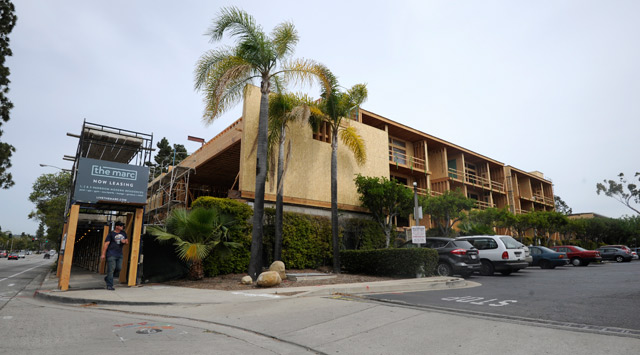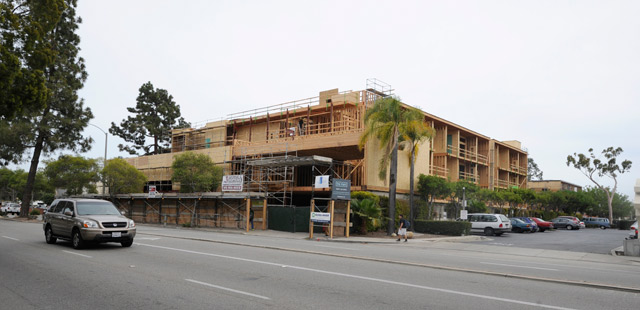Has Housing Experiment Created a Monster?
City Leaders Gasp at 36 High-Density Projects in the Pipeline

By most standards, Santa Barbara’s high-density housing experiment has been nothing short of a wild success. In just three years, the program’s grab bag of incentives accomplished what city planners struggled to achieve for decades — usher builders away from luxury condos and stimulate the development of smaller, more affordable apartments. Thirty-six new high-density projects now sit on the horizon, representing potential relief for workforce renters priced out of the city’s drum-tight housing market. But for some Santa Barbara leaders, even those who helped shape the magic formula that’s given rise to the building boom, the experiment is working too well.
Last week, in an op-ed piece published in this paper, Councilmember Bendy White asked City Hall to pause and reevaluate its Average Unit-Size Density (AUD) Incentive Program, a policy hatched in 2013 out of prolonged negotiations between slow-growth and smart-growth advocates involved in the city’s General Plan update. Both sides agreed that housing needs had reached critical levels — vacancy rates were dipping below 0.5 percent — but they had a hard time finding a solution. Parking became the sticking point. It was some deft political maneuvering by White around his more conservative pro-car colleagues that led to the compromise wherein developers would be allowed to squeeze more units per acre into their projects and offer fewer parking spots per unit. The double hit of increased density and added building space proved potent investment catnip.

White’s concerns that the AUD is moving too fast too soon crystallized when he read a Planning Division report in late March that highlighted pending and approved projects under the new program, which includes a test phase of eight years or 250 completed units. “The numbers took my breath away,” White said. Over the last six years, the city added 455 total housing units, including single-family homes, multifamily condo complexes, and low-income residences. At the moment, there are 1,308 units in the pipeline, 753 of which are AUD rental projects; two AUD units have been certified for occupancy, 132 are under construction, 166 have been approved, and 421 are pending review.
The list includes proposals to demolish the oriental rug store on South Hope Avenue and build a four-story, mixed-use development with 48 residential units; tear down the warehouse and next-door home at the corner of Anacapa and Ortega streets to construct a three-story, mixed-use building with 30 units; create a mixed-use, 21-unit project on a vacant lot at 825 De la Vina Street; replace the office building at the corner of Santa Barbara and De la Guerra streets with a 23-unit project; and convert Capitol Hardware & Building Supply on Milpas Street to four stories of mixed use and 71 units.
“All of those could be under construction or completed within the next two years,” White warned. If that were to happen, “everyone would be stretched — planners, traffic engineers, neighbors.” The city as it exists today can’t accommodate such a building blitz, White said, the likes of which he hasn’t seen since 1959 when around 1,000 units quickly went up in San Roque. Any solution needs to be rolled out in a “sustainable, nurturing” way so as not to degrade existing residents’ quality of life. White suggested that the city limit growth to the more traditional rate of around 100 units a year and consider mitigation fees in the range of $10,000-$20,000 a unit to help offset the added wear and tear on roads and other infrastructure.
In White’s corner is Councilmember Jason Dominguez, who was similarly struck by the Planning Division figures. Dominguez also worries if the AUD is attracting the kind of housing and residents the city really wants. The units being built are “small and pricey,” not ideal for young families or city workers, but better suited for retirees, students, and telecommuters. And catering to millennials can be tricky, Dominguez said, because millennials tend to be “all about experience, but what happens when they have their Santa Barbara experience and then just move on?”
Dominguez said it would be unwise for the city to “put all its eggs in one basket” by investing so heavily in rentals when there’s only a finite amount of land on which to expand. As a community of 60 percent renters, we’re already far above the national average of 35 percent and seemingly destined to skew even higher. “Really, we should want to encourage ownership,” said Dominguez. Homeowners tend to live healthier, better-educated lives and invest more deeply in their neighborhoods, he said. If high-density, mixed-use projects are eventually built, he went on, they should to be “brownstone quality.”
Like White, Dominguez isn’t suggesting the AUD program is flawed in principle. But he said enough has changed in the Santa Barbara housing landscape since it was implemented three years ago — more students and Airbnb renters to contend with, along with dwindling water supplies — that it deserves another look. “It’s my job to understand what the city wants and figure out if this is the right policy to get us there,” he said.
Though new development is often alleged to add undue water demand during the drought, the reality is new hookups represent a tiny fraction of overall usage. In a presentation to the council last Tuesday, city water manager Joshua Haggmark explained if every pending residential project were built — an unlikely scenario given many development proposals never leave the drawing board — demand would increase less than one percent of our annual drought-time water supply. Suspending all development permits would save just 28-40 acre-feet of water a year, or 0.29 to 0.41 percent of the drought supply.

Architect Detlev Peikert, a principal at RRM Design Group who’s been a longtime proponent for more workforce housing and who’s utilized the AUD program for a number of his recent projects, said he was surprised by the councilmembers’ anxieties. “It is, in my opinion, an overreaction,” he said. “The AUD has been successful, and that’s a really good thing.” Taken as a moment in time, the development spike may look intense, Peikert conceded, but it should be seen as part of the bigger picture. Construction happens in spurts depending on the economy. “Right now, we’re making hay,” he explained. “I really don’t think there is any need for the city to embrace a whole new system of growth control.”
Lisa Plowman of the Coastal Housing Coalition agreed “there is a lot of unnecessary fear around the AUD program.” Not a single unit is occupied, so it’s premature to speculate on problems that don’t yet exist, she said. “Let’s get some built before we start making changes to a program that’s so very new.” Peikert and Plowman acknowledged the growing pains of neighborhoods in transition as residents watch single-family homes morph into two- and three-story developments, but they cautioned against assuming the projects won’t succeed simply because they’re different.
As to the repetitive predictions by neighbors that already limited on-street parking will be gobbled up by new AUD tenants, Peikert said many older buildings only supply a single space per unit, which is what’s now allowed for AUD rentals. “It’s not the end of the world, and it’s not particularly new,” he said. “People adapt.” Plus, he went on, how residents get around will change dramatically in the next 10-15 years, with the emergence of self-driving cars and increasing viability of car-sharing programs.
Chief transportation planner Rob Dayton said the city is actively studying car-sharing options and will soon solicit proposals from vendors. He and others at City Hall see it as the answer to a lot of neighborhood worries. “We want this solution to be applied as much as possible,” said Dayton. He also acknowledged that the city has the option to create additional 90-minute parking zones that would serve businesses near AUD projects during the day and tenants at night.
Though White states his motivation for pumping the brakes on the AUD program is to save the city from veering off course, there are those who accuse him of speaking out for political reasons. “Why is he bringing this up now?” asked Mickey Flacks, who’s toiled on the front lines of the housing crisis longer than most millennials have been alive. “Maybe because he wants to run for mayor.” After all, it was only six months ago that then-councilmember Dale Francisco suggested his colleagues revisit the AUD, pointing to a surprisingly high number of projects in the pipeline. He got no traction with White. Flacks and others think White is trying to appeal to residents spooked by rapid development as well as older homeowners, who make up most of Santa Barbara’s voting base. “It’s scare tactics,” said Flacks.
“Baloney,” responded White. Land-use planning has been a central theme of his professional and public service life for the last 30 years, and fresh questions about the AUD fit squarely in his field of vision. “I worked on the [General Plan update] for a decade, and I want it to function after I’m gone,” he said. “I don’t want to leave behind a mess.” White declared he wants to turn his “surprise into something sustainable” and “at least start a conversation.” That will increase transparency, he said, “And that’s a good thing.”



